About 1,200 kilometres south we reach Kingman Reef, which barely grazes the ocean surface. It’s the pilot’s cue to start our descent into the dense fog of the equatorial convergence zone. Our tight fuel budget allows one shot at landing; a second circuit after an observational fly-by is simply not possible.
The relic-crushed coral runway rushes out of the blur and provides a terrifyingly violent landing as we pound and plough along it. The commotion spooks fleets of tropic birds and flushes red-footed booby colonies into the sky. As we exit the aircraft, the air is thick with wheeling birds. We have arrived at Palmyra Atoll.
Jointly managed by the U.S. Fish and Wildlife Service and the Nature Conservancy, the atoll is a unique collection of natural reefs and engineered islets and lagoons. It may look like a postcard paradise, but 10 years ago Palmyra was in ecological freefall, with bird populations and native forest diminished - all because of the human introduction of rats nearly a century ago. A trophic chain collapse was gaining momentum and action was required.
After a major restoration effort, today Palmyra is exploding with wildlife, a case study for the successful rewilding of our damaged natural world. The recovery shows that an anthropogenic crisis can be reversed, and that a biodiverse future can be realized if we act in a timely manner.
On arrival day, our crew of six visiting conservation scientists doubles the population of the coral atoll. As we settle into base camp, Dr. Alex Wegmann, the chief scientist who oversaw Palmyra’s recovery briefs us on the atoll’s geographic structure and the protocols for traversing the landscape to ensure our safety and, most importantly, the protection of biosecurity.
It’s a long way from help here, Wegmann warns us wryly. The 235-hectares of land consists of the major island Cooper, where the runway is located, and a surrounding ellipse of 25 islets that create inner lagoons, some of which are connected by engineered causeways.
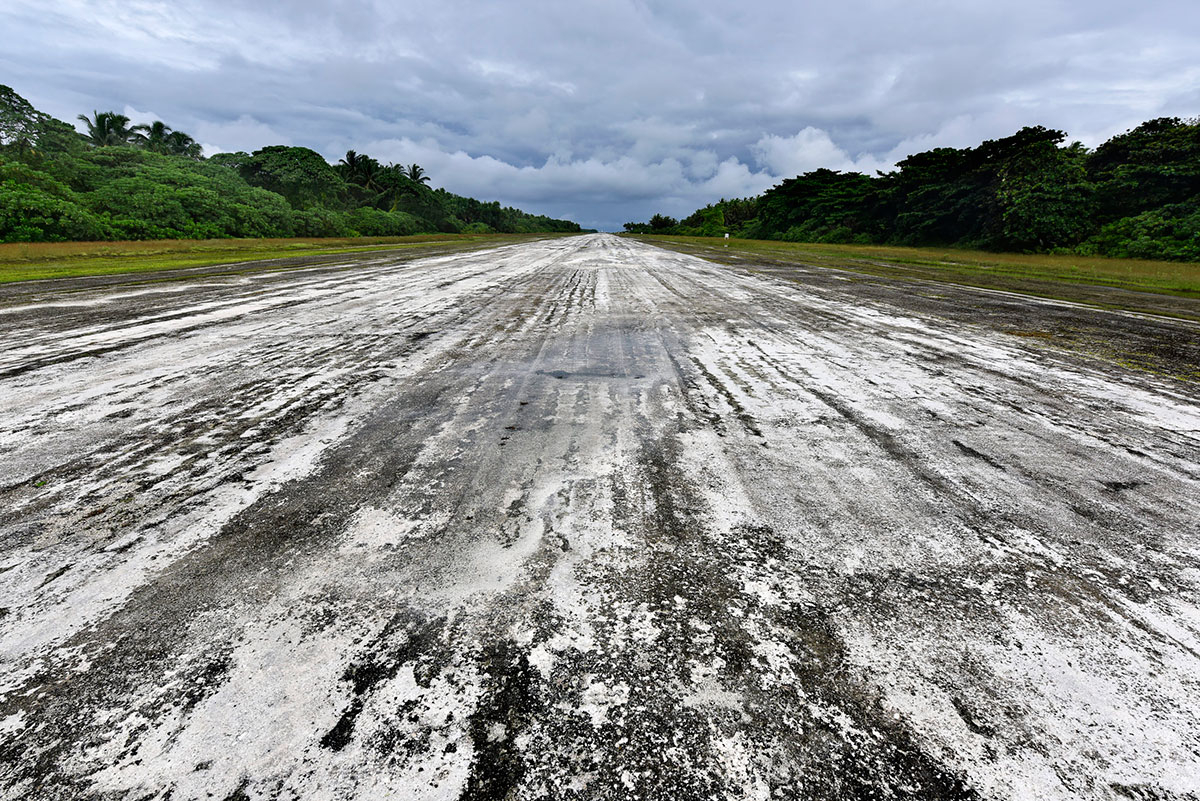
Biosecurity is top of mind for Wegmann and Stefan Kropidlowski, Refuge Manager for Palmyra Atoll National Wildlife Refuge, and we get a strict lecture on the importance of washing and freezing our clothes when we return from the outer refugia islands to the main atoll. This is to avoid infestation from invasive insects; ants have made a small foothold on Palmyra, and the protocol is aimed at preventing their spread before eradication.
The USD $5-million restoration of Palmyra took place a decade ago. Rats destroying the islands were removed, and the flora and fauna has now rebounded. Wegmann is rightly proud and defensive of this achievement, which could so easily be lost with a careless re-introduction due to a lapse in protocol. I am grateful to Kropidlowski because several pre-trip calls have prepared me, and I am fully equipped to explore the outer islets.
Over dinner on our first evening, Wegmann sets a 5:30 a.m. start for the next day. He wants to get me out into the forest before sunrise. The hour comes, and it’s a rude awakening after a hot, humid and restless night. Blurry eyed, I haul my 30 pounds of camera gear and we meet at the main building. Wegmann is buoyant and ready to go. I stumble behind him as we disappear into the dark undergrowth of the pre-dawn forest.
The forest floor is littered with land crabs. When Wegmann first arrived on Palmyra, the atoll only had seven of the larger species. But now 10 different species are flourishing, from giant coconut crabs to the almost translucent and tiny ghost crabs. This is because when the rats reigned the atoll, the crab larva would drift from their spawning grounds on the southerly Line Islands to wash ashore on Palmyra where, as juvenile crabs, they’d be eaten by the rats. But with the rats gone the crabs now thrive upon landfall, just one hallmark of a vibrant ecosystem.
My eyes are glued to the ground, desperate not to crush a crab with a poor footfall, and I can barely keep up with Wegmann as he seemingly floats through the forest. An hour later we arrived on the western beach of Strawn Island. I am totally disorientated. Wegmann laughs and explains that this is the perceived location of a mythical hermit — or perhaps, as he suggests, the strange evocative light that sometimes appears is simply the ghost of a missing and presumed murdered past island dweller. I am not falling for the tales of the islanders, but the atoll’s history is steeped in myth and murderous truth.
Our bushwhacking has not been filled with idle chit-chat. Wegmann has given me a crash course in the island’s ecology and its multi-century trophic chain collapse. It’s a fascinating perfect storm set against the complexities of evolution and island biogeography. As the first warm light of sunrise illuminates the trees, a flock of red-footed booby seabirds take to the sky, a glorious sight, and Wegmann rejoices — this is the reward of a rewilded atoll.
Collapse and Recovery
Wegmann came to Palmyra in 2004 as a greenhorn botany PhD candidate with a mandate to understand why the island’s endemic trees, the Pisonia, were in decline. The trees are critical nesting habitat for native birds, and it was feared that their decline was also harming bird populations. For Wegmann, the atoll was simply a field site, a stepping-stone on a conservation scientist’s career path. But with time the island’s importance as a global case study crept into his soul, and he remains director of science for Palmyra at the Nature Conservancy.
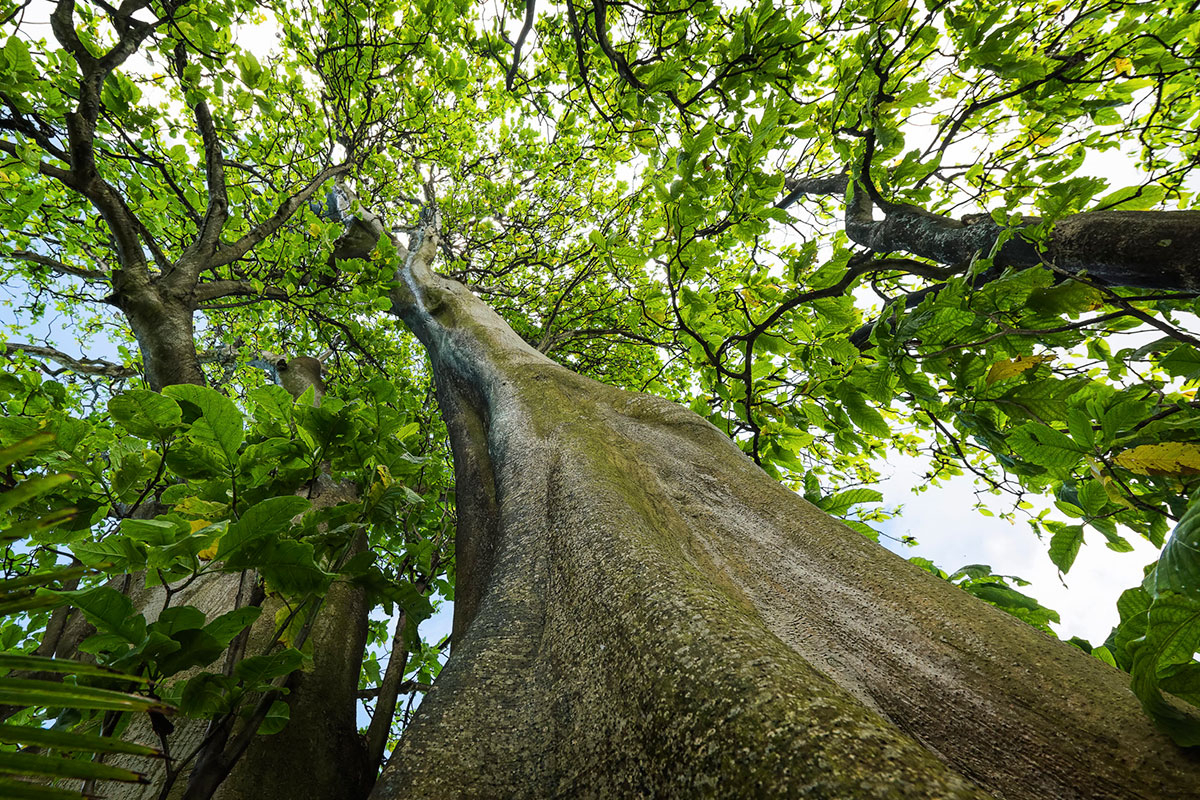
After three years of tramping through the undergrowth and conducting rigorous and carefully deployed seedling trials, Wegmann saw the fuller picture. He realized that a trophic collapse far more complex than any envisioned by his PhD supervisor was underway on Palmyra, one that had started centuries before. In evolutionary timescales, it was like a freight train hitting a wall.
Waves of invasive species had carved out an existence on the atoll. It started with the Polynesian introduction of coconut trees, followed by waves of European settlers who tried their luck at cattle ranching and intensive coconut farming. These endeavours left early negative impacts that would soon be amplified.
The attack on Pearl Harbour in 1941 resulted in a massive re-engineering of Palmyra’s structure. Coral reefs were dredged and desecrated to form runways as the American navy engineering corps created a strategic monitoring outpost on the islands, a first line of defense against imperial Japan. Precipitously, the Americans also introduced rats that stowed away on the supply ships.
The uninvited rats were bequeathed a paradise with abundant food to satisfy their voracious appetites, and their population exploded. They targeted seabird chicks and eggs, and the seabird populations began to fall. As their food sources shrank, the ever-adaptive rats learnt to attack almost any fresh biological source. In ecological terms it was a disaster. Meanwhile, the native Pisonia trees were in decline, as were the once numerous land crabs.
For Wegmann, it was an utterly frustrating and bewildering process to unravel. Dozens of trials of seedlings at different locations failed to illuminate why the forests were failing.
One day in a reflective moment, Wegmann watched as land crabs idled through the forest floor. As expected, the crabs fed vigorously on the seeds, much like the rats. But an important difference caught Wegmann’s eye. As the crabs perambulated across the loose soil, their legs tended to bury as many seeds as they consumed. It was a revelation; the crabs were forest farmers tiling and sowing the seeds into the soil and being rewarded to do so — a remarkable example of symbiotic evolution.
Camera traps revealed that the rats would devour the entire seedbank and further still predate on the occasional seedling shoot that survived to germinate. The rats were eradicating the endemic forest because the natural seedbank no longer existed. It was rat-induced extirpation. The revelation was hard earned, and the fact that it secured Wegmann his PhD was of little consequence, with the island clearly in ecological free fall.
Eradicating the rats would require significant resources. Wegmann’s work pivoted to rewilding the island. He reached out to the world’s preeminent conversation organizations: Island Conservation, the Nature Conservancy and the U.S. Fish and Wildlife Service. They responded, raising funds and resources and mobilizing biologists and technical specialists.
It takes four years of careful planning and four weeks of intensive ground execution to eradicate an island of rats.
As Gregg Howald of Island Conservation said, “It takes four years of careful planning and four weeks of intensive ground execution to eradicate an island of rats.” But a bespoke island specific plan was needed to ensure success, especially if native species were to be protected from unintended impacts of the poison bait.
Helicopters, barges, mechanics, pilots, biologists, medics and cooks — all descended upon the island for the intensive campaign. As the poison bait fell from the helicopters, the beginnings of a massive reversal in the island’s ecological collapse began. Four weeks later, not a single live rat could be found on camera or in a traditional trap. Six anxious months passed and still no detectable rat activity could be found. Finally, after a torturous year, the island was declared rat free.
Eight years later, Palmyra’s biodiversity has rebounded. Bird colonies of red-footed boobies and frigate birds abound. Terns are present in phenomenal numbers. The island is alive from dawn to dusk and is an absolute thrill to experience. Diving on the corals is wondrous, as the reefs teem with life. The healthy reefs nurture plentiful forage fish, which in turn enables the top predators to thrive. The surrounding waters are now home to manta ray — and I gasped when a pair of neon lemon sharks torpedoed past us in the sunlight.
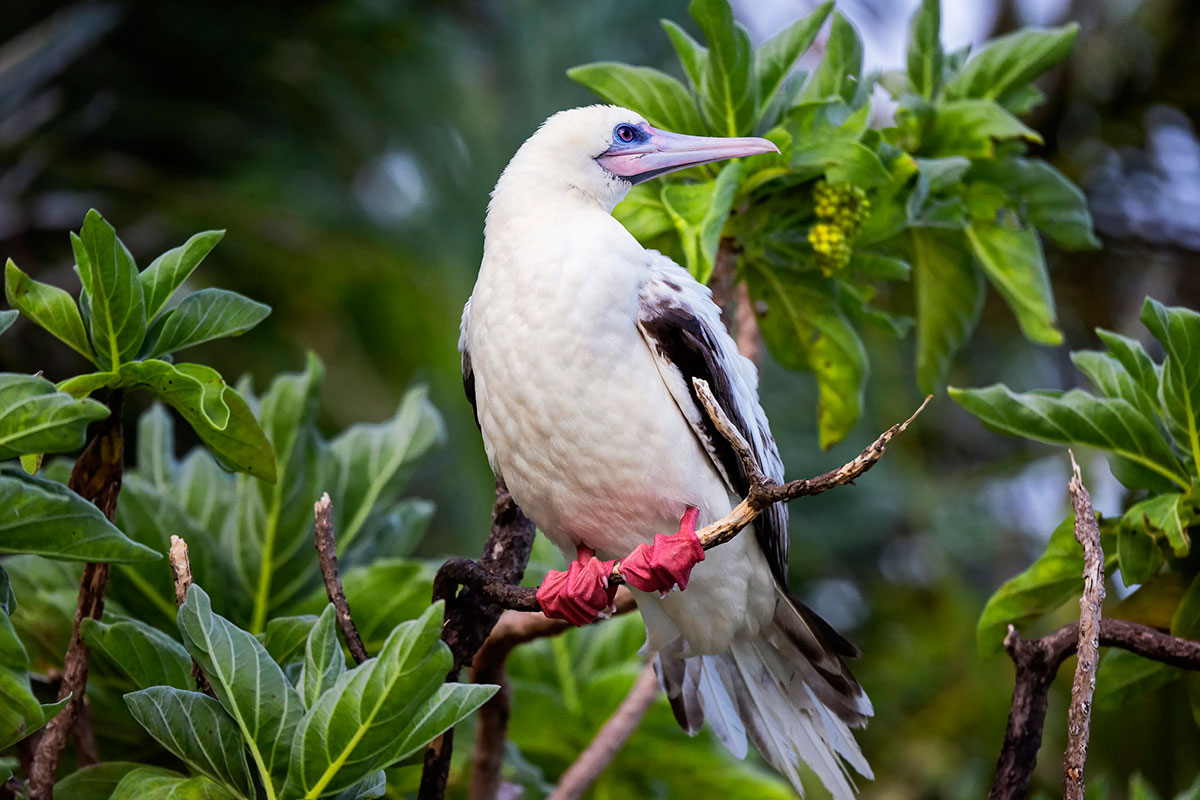
In these moments I believe I felt the same sense of awe that must have enveloped Charles Darwin and Alfred Russel Wallace as they immersed themselves on remote islands not unlike Palmyra. It was a profound moment of awareness; one I feel privileged to have experienced. I will be forever thankful to Island Conservation for sending me to this place.
Misadventures
It’s day two and Dr. Nick Holmes, director of science for Island Conservation, rallies the team for a week of deploying song meters on the remote refuge islets of Palmyra. The instruments record bird song at a given sample rate every day. This assesses both the number of birds and species diversity post-rat eradication, along with helping determine population peaks and the island’s natural carrying capacity.
On the dock, as per protocol, we change into our frozen clothes, a delight in the humid 35-degree Celsius equatorial weather. It is quite the effort transferring all the equipment to the boats and changing clothes, including backpacks and camera bags, into frozen ones. By the time we boat out to the islets, over two hours has passed. Upon arrival we are dismayed to find a critical component of the song meters is broken. We must return. I balk at the time loss and convince the team I’ll be safe enough on my own to document the biodiversity with my camera. They leave me in paradise, and not three minutes after their departure, I’m in trouble.
As the boat leaves, I spot a pair of brown booby seabirds huddled on the overhanging limb of a coconut tree across the lagoon. I dump my gear on the shore and wade into the ocean with my camera and telephoto lenses, seeking the perfect photo composition. The tidal range on small remote islands is only a few feet, and as I traverse the low tide mark the footing becomes decidedly “suctionous” — but I stupidly push out to my perceived optimum spot anyway. Standing stationary and engrossed in taking the picture, I slowly become locked in the vacuum-powered mud. I’m soon horrified to find that I’m seriously stuck. Suddenly every movement has me pinned and threatens a fall into the water, camera and all.
I have no option but to wait for two hours or lose my camera, and I soon realize it’s not possible to last that long in the baking heat. Some foot-wriggles reveal that my waterproof sandals are the core problem - I have to ditch them, but I need them for the week (they’re my “protocol” shoes!). So, with some trepidation, I triangulate my position off three trees, slip my feet clear of my shoes and slowly crouch down into the water. As I become buoyant, I push my camera above my head and let my legs finally become free. Like a demented sea turtle, with my face mostly submerged, I waggle towards shore. Seriously out of breath, I get my camera to the beach. Ten minutes later, duck diving in the muck, I retrieve my shoes and wash up in the firm footing of the shallows.

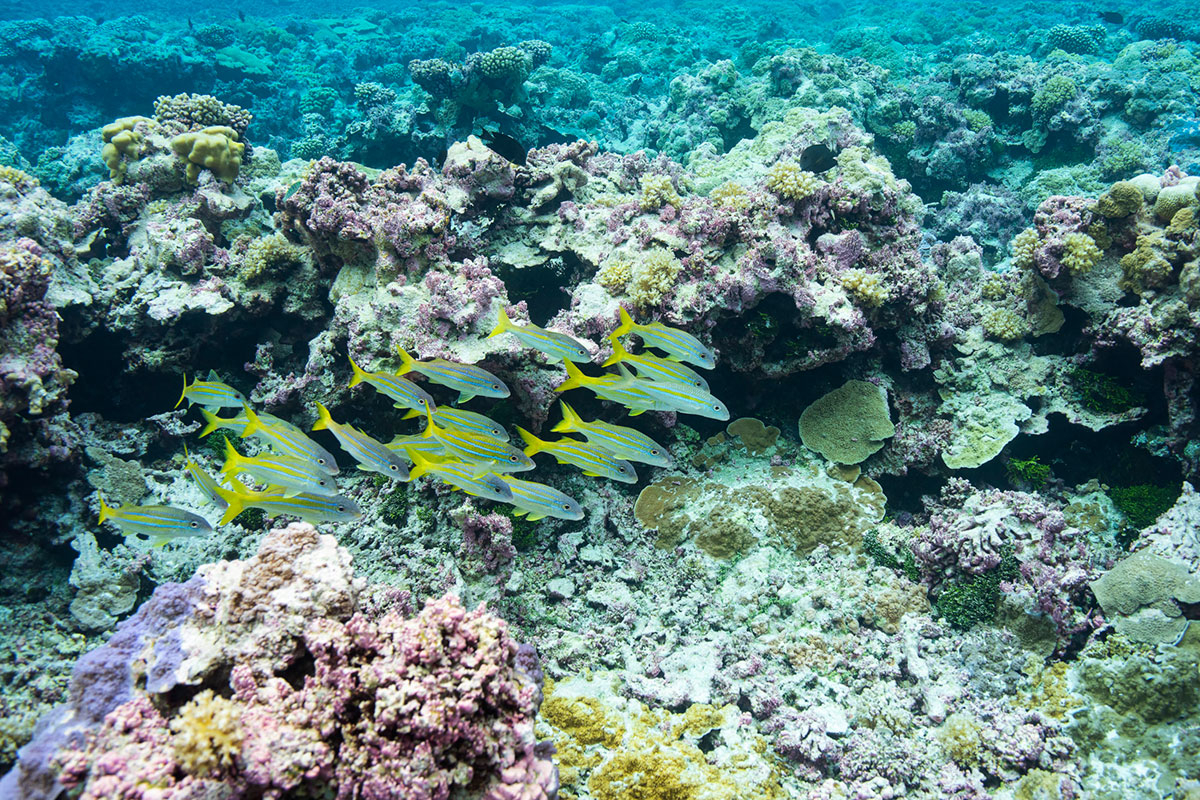
Giant Clams and Vibrant Corals at the eastern reef of the island
Reflections and Revelations
Reflecting on my misadventure and drip-drying in the shade of a coconut tree, my thoughts wander to the rewilding of Palmyra. This is an extraordinary place – teeming with life it triggers thoughts and notions of evolutionary trajectories and the Hillis plot comes to mind. The plot is a visual representation of the genetic tree of life, constructed from the DNA of over 3,000 species and inspired by early designs of the 18th century.
Proposed by Professor David Hillis and his team at Texas University in 2003, the plot is constructed by turning speciation branches in a radial direction, with common ancestral trunks growing outward from the centre (Science, 2003, 300:1692-1697). The evolutionary tree evolves because the common or shared DNA is recorded like a tree trunk growing up, or in this case outward. When speciation occurs, like a tree branch that splits in two, the path takes a radial or circular path.
Figure 1 Historical Tree of Life Variants

Much like heritage trees of life depicted in Charles Darwin’s era, but with a profound clarity, the modern DNA tree is a powerful revelation. All species on Earth are related, and we all share common ancestral DNA. We are kin and cousin to all life on Earth. This revelation is a lived experience for many Indigenous Peoples, for their cultures embrace and care for fauna as kin, something that science-based cultures have lost.
Figure 2 The Hillis Plot
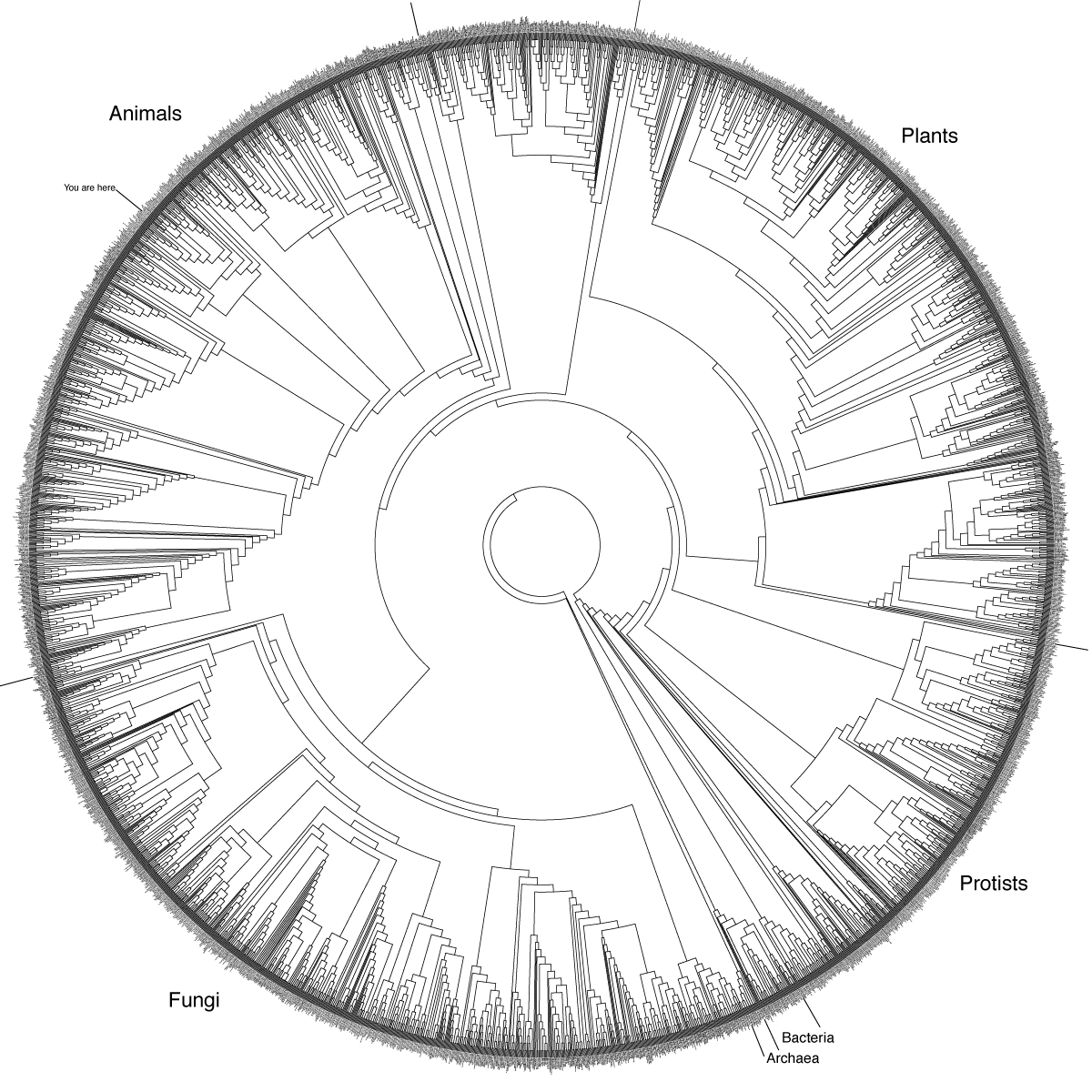
The Hillis plot was created by David M. Hillis, Derrick Zwickl, and Robin Gutell, at the University of Texas.
The tree is from an analysis of small subunit rRNA sequences sampled from about 3,000 species from throughout the Tree of Life. The species were chosen based on their availability, but the major groups, were sampled very roughly in proportion to the number of known species in each. The number of species represented is approximately the square-root of the number of species thought to exist on Earth (i.e., three thousand out of an estimated nine million species), or about 0.18% of the 1.7 million species that have been formally described and named.
Life on Earth is always changing — sudden planetary scale extinction events have occurred, eliminating many higher order life forms. Yet biodiversity becomes re-established over millions of years. However, the re-established lifeforms are often new flora and fauna that are previously unknown.
It strikes me that embedded within the Hillis plot is the notion that evolutionary trajectories are not hardwired and encoded. Rather, natural ecosystems, when provisioned with resources will expand and adapt the range of flora and fauna to maximise the biological utility of the available resources.
And it’s fundamentally encoded into the process of evolution — the outer layer of the Hillis plot for different eras and eons would look quite different, but the core ancestral DNA foundation would remain.
That’s if and only if, we do not eliminate whole groups of taxa or unique deep genetic lineages. The tree could be redrawn as if nothing was lost, but the hundreds of millions of years of evolution that are taken out with deep-branch extinctions are never gained back. Even if new species emerge, the tree of life only adds short branches at the tips. Gone is the rich accumulation of genetic adaptations across deep time. It is this lineage that provides the foundations of our very existence — the global ecosystem, a collection of fully integrated symbiotic flora and fauna.
Looking at Palmyra and remote islands in general, the variation in speciation is different from that of the continents, despite common ancestors. Indeed, this is the clue that Darwin and Wallace observed, and which triggered their insights. The fossil record also reveals that significantly different evolutionary pathways have also developed at continent scale after each mass extinction event. Evidence that evolutionary pathways are not specifically encoded.
Each recovery has yielded a different range and type of flora and fauna. The observation is important because it allows us to imagine an escape from the depth of the ongoing anthropogenic mass extinction that we are currently witnessing. Blinded by the pursuit of economic growth to the impacts of our existence upon natural security (or ecosystem services provisioned by a biodiverse planet), we are the architects of the current extinction era. However, we have not escaped our dependency on the world’s ecosystems for food, water and clean air. This is weaved into the Hillis plot, for all life on Earth has symbiotically evolved. Without a viable natural world, our existence is threatened by our own actions.
The Hillis plot can also be regarded as a measure of biodiversity or ecosystem health. Systems that are productive will exhibit a full spectrum of species as a full outer ring. Compromised ecosystems may have missing outer leaves, branches and sections. The damaged ecosystem may be impaired due to pollution, climate change, habitat loss or even the introduction of an invasive species such as rats.
Reflection on the Hillis plot allows the imagination to consider an Accretocene, an era of rapid biological productivity catalyzed by humanity. This is in opposition to the current destructive Anthropocene. The creation of the right conditions allows for nature to rewild impaired and impacted regions. Rewilding is important language, not to be confused with repair or restore.
Palmyra demonstrates that by creating conditions for bio-productivity to thrive, ecosystems rapidly generate (not regenerate). They may or may not resemble a facsimile of what was once. This is an important distinction, and it allows us to imagine the possibility of rewilding on a global scale. Figure 3 attempts to capture this rewilding Accretocene vision. We just need to create the conditions for natural processes to exploit. The diagram has a nonlinear timeline displaying a short destructive Anthropocene followed by an enduring multi-eon timescale in which a biodiverse world is rebuilt. This is fundamentally the work of Island Conservation — a wild, beautiful aspiring endeavour that provides a truly hopefully and scalable vision for the planet.
Figure 3 Evolutionary Trajectories

The ideas are expanded in Figure 4 to demonstrate multiple pathways. Three emerge. The first is a rapid response rewild intervention trajectory catalyzed by humans, preventing deep genetic lineages from being lost. While extinctions cannot be reversed, the world’s biodiversity is still sufficiently broad that the existing ecosystem function would be retained. The second trajectory illustrates the slow multi-million-year response when deep loss of biodiversity occurs. When deep genetic lineages are lost, the range of biodiversity and by extension the resiliency of ecosystems is contracted. Building new and different flora and fauna occurs at a much slower pace defined by evolution and adaption. This consideration demands for global adoption of conserve and repair polices to be introduced. The third deep extinction trajectory envisions an almost complete loss of life, requiring billions of millennia for a biodiverse world to return, if indeed possible.
Figure 4 Variant Trajectories

On Palmyra, the rats liquidated biodiversity. But the eradication project allowed it to rebound. However, the original Pisonia trees are still pressured because of the invasive coconut tree, which grows significantly faster, closes the canopy, and out competes the native trees for sunlight. Understanding this core ecosystem characteristic allows Wegmann and the team to envision a future in which these forests can be recovered by careful removal of coconut groves and replanting of native trees.
Indeed, this is the next phase of Island Conservation’s work, to be carefully considered and orchestrated. For example, birds currently nest and thrive in the native forests, but they’ve adapted to find their nests and chicks by navigating from the open ocean along defined flight paths marked by physical features and characteristics — often coconut trees. The rapid removal of coconut trees to allow native forests to be replanted might harm the bird populations by preventing them from returning to their nests. Thus, careful and respectful manicuring will be required.
Rewilding is often critiqued as a notion of playing God with an ecosystem, as a species we already do — just very badly. The lessons of Palmyra extend to the whole planet. We could play much better. Island Conservation is a global leader in this endeavour. Enabling an Accretocene is a simple global human choice.
My Hope
The team returns to the islet. Holmes, the science director, looks quizzically at my mud-streaked salt encrusted face, while Wegmann quips “not too smart sitting underneath coconut trees — they tend to drop coconuts on your head.”
“That’s only a half of it,” I retort. A few minutes later they’re all laughing as I regale them with the details of my last few hours.
It’s been 10 years since the rats were removed from Palmyra. The atoll’s bird population is exploding, seedlings are thriving — and the once diminished forest is rebounding. The islands are feeding the surrounding reefs. My hope for the next decade is that the work of Island Conservation and its partners is globally recognized, supported and embraced.
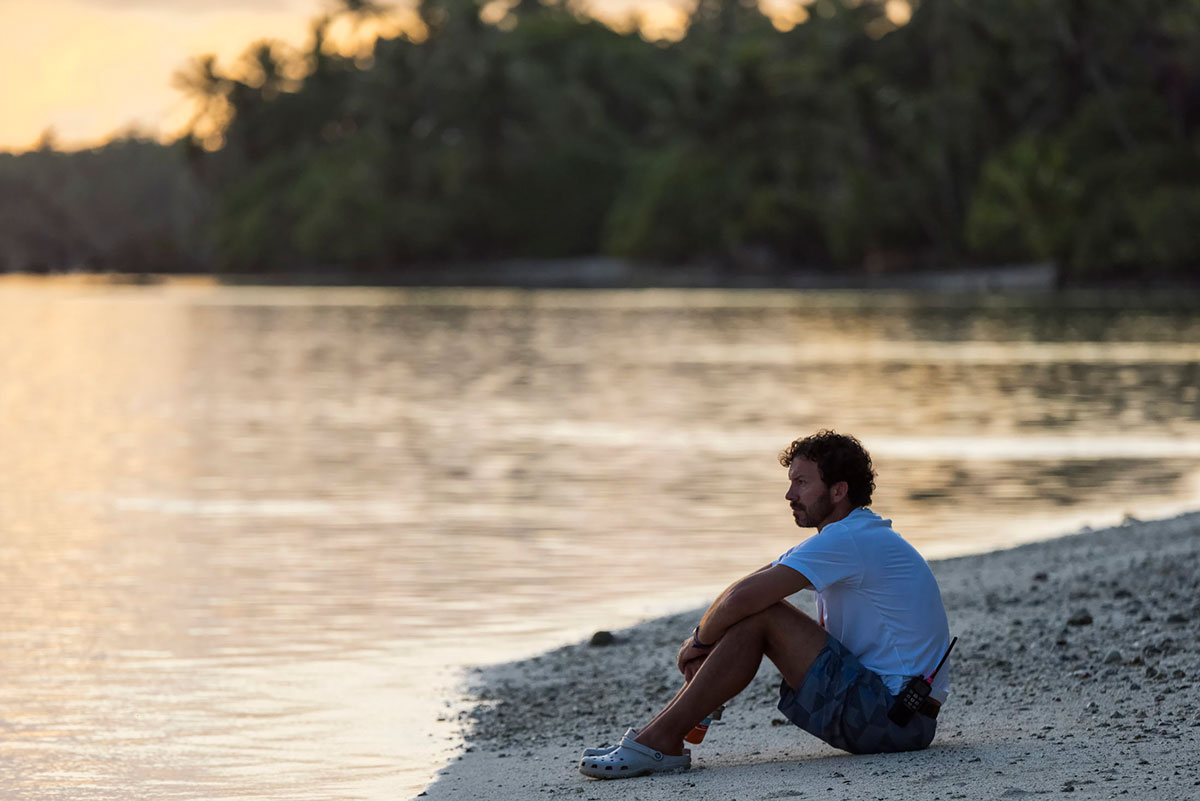



Comments